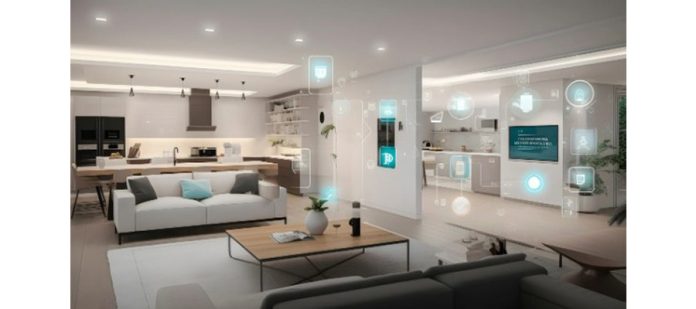Wi-Fi has been the dominant technology for wireless networking for more than two decades. It has evolved significantly over the years, with faster speeds and greater range. Wi-Fi is an excellent choice for high-bandwidth applications like streaming video, as it can handle large amounts of data quickly.
With the rise of the Internet of Things (IoT) and the smart home, the importance of Wi-Fi has only grown. However, with all wireless technologies come limitations, and Wi-Fi’s primary design for high throughput makes it power-hungry, limiting its applications for low power, or battery-powered devices like those found in the smart home and IoT ecosystems. However, these limitations are mitigated through the release of the Wi-Fi 6 standard as well as interoperability with the Matter standard and Thread protocol.
Wi-Fi 6
Fortunately, the Wi-Fi 6 standard has improved operating conditions through included power-saving technology that allows designers to trade some throughput for longer battery life. By using a multi-access modulation technique called orthogonal frequency-division multiple access (OFDMA), each of Wi-Fi 6’s 20MHz channels can be divided into hundreds of sub-channels, enabling it to support many more devices concurrently. These enhancements make Wi-Fi 6 a good choice for smart home appliances such as security cameras, smart thermostats, and smart speakers.
Matter
Moreover, Wi-Fi plays a foundational role in the new Matter standard, which promises to bring interoperability to smart home ecosystems. Matter incorporates Thread for low-power wireless connectivity, using Wi-Fi when greater throughput is needed, and as a result, more power is available. Matter also includes the Ethernet-wired standard and Bluetooth Low Energy for commissioning. Together with the other protocols used for Matter, Wi-Fi can support Internet Protocol (IP), which is essentially a network layer communication standard for rapidly moving data across the internet. This interoperability with IP makes it very easy to connect each smart home product to the cloud, making smart home applications very powerful and flexible.
Matter’s backing by Apple, Amazon, Google, Nordic, Samsung, and hundreds of other firms brings structure to a previously fragmented smart home sector. Customers will be able to purchase a smart device made by any mainstream supplier and then easily integrate the device into their preferred smart home ecosystem. This suits major suppliers eager to offer value-added smart home services to consumers, thereby multiplying the revenues from device sales. According to Vantage Market Research, a smart-home sector worth $75 billion in 2020 will expand over five-and-a-half times by 2028, resulting in over $420 billion in sales per year. As part of that total, shipments of Wi-Fi-based, smart-home devices will increase at a 21 percent compound annual growth rate from 2021 to 2025.
Thread
Thread is a relatively recent protocol that is specifically designed for IoT. Thread is an IP-based protocol optimized for low-power devices, making it an excellent choice for smart home devices that run on battery power. It is also designed to be very reliable and secure, making it a desirable option for applications where security is a concern.
Wi-Fi and Thread are different technologies and do not compete. In fact, they can be used together to create a more robust IP network. For example, Wi-Fi could be used to connect high-bandwidth devices like smart TVs and streaming devices, while Thread could be used for low-power devices like smart thermostats and sensors, as we see in its use with the Matter standard.
One of the benefits of using both Wi-Fi and Thread together is that it allows for more flexibility in the design of IoT systems. For example, some devices may be better suited to Wi-Fi because they require a high-speed connection, while others may be more appropriate for Thread because they require low-power operation. By using both technologies, designers can tailor their systems to meet the specific requirements of each device.
Another benefit of using both Wi-Fi and Thread together is that it can improve the reliability of the network. Wi-Fi is prone to interference, but by using Thread for low-power devices, designers can reduce the risk of interference and develop more dependable networks.
Wi-Fi and Thread are both excellent options for building IP networks for IoT. As IoT continues to grow, it is likely that we will see more protocols and technologies emerge that are designed to address the unique challenges of building IP networks for smart devices.
Nordic Products Designed to Help Designers
Nordic Semiconductor is making it easier for developers to innovate low-power IoT applications and take advantage of Wi-Fi’s increasingly important role in the smart home by introducing the nRF7002 Wi-Fi 6 companion IC and its associated development kit (DK). The IC is a low-power Wi-Fi 6 device that provides seamless dual-band (2.4GHz and 5GHz) connectivity. The nRF7002 also offers excellent coexistence with Bluetooth Low Energy, Thread, and Zigbee radios, and supports Wi-Fi 6’s Target Wake Time (TWT), a key power-saving feature. The DK makes it easy for developers to get started on nRF7002-based development because of the nRF5340 SoC host processor. The nRF5340 multiprotocol SoC supports Thread and Bluetooth Low Energy, making it suitable for development with all the Matter standard’s wireless technologies.
Conclusion
With the smart home set to become more popular and mainstream, it’s crucial to ensure that devices work together seamlessly, and Wi-Fi’s interoperability with IP and support for Matter will play a fundamental role in its success. By using the power-saving features of Wi-Fi 6 and Thread and taking advantage of Matter’s interoperability, smart home devices can be powerful, flexible, and energy efficient.



